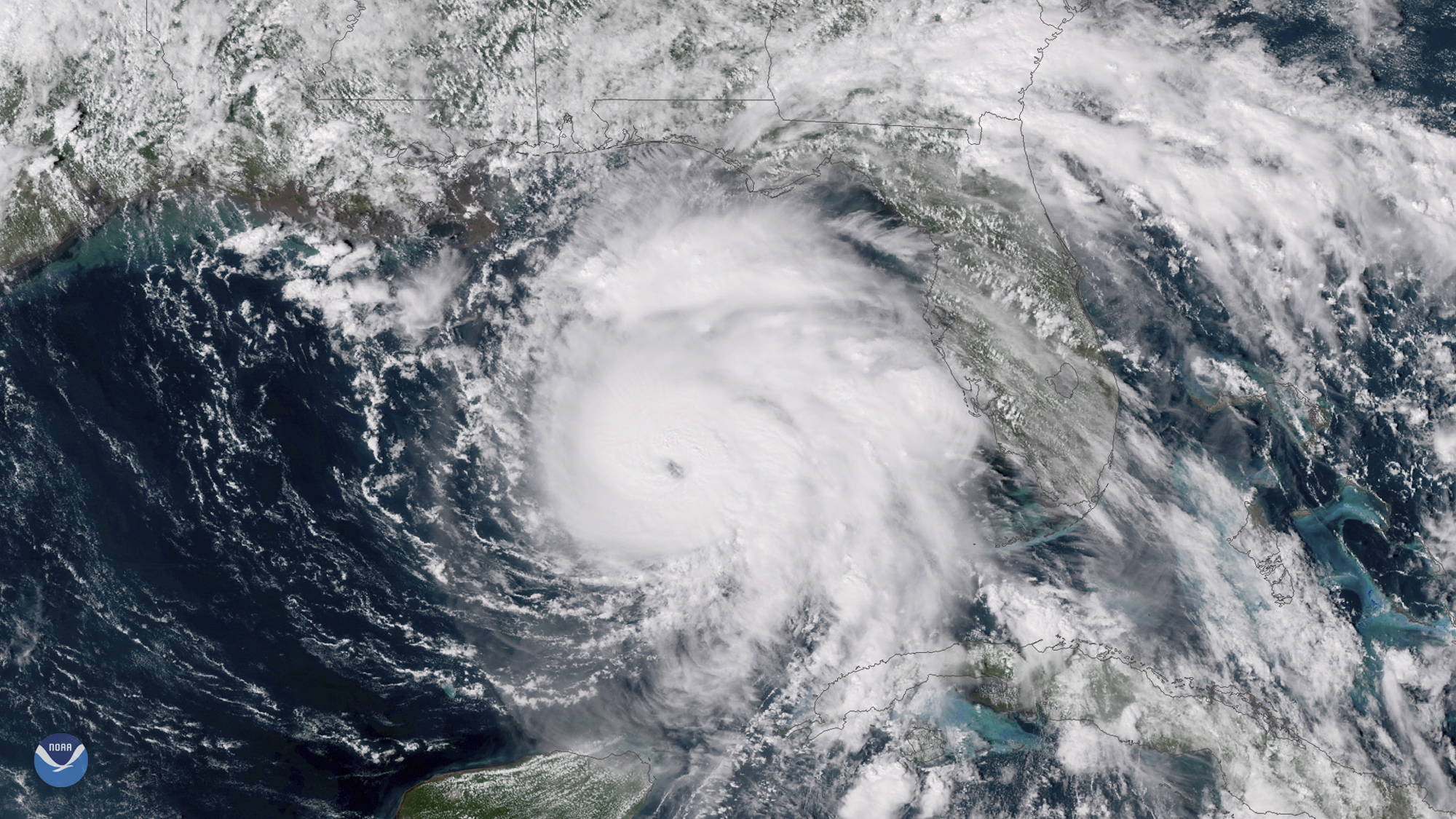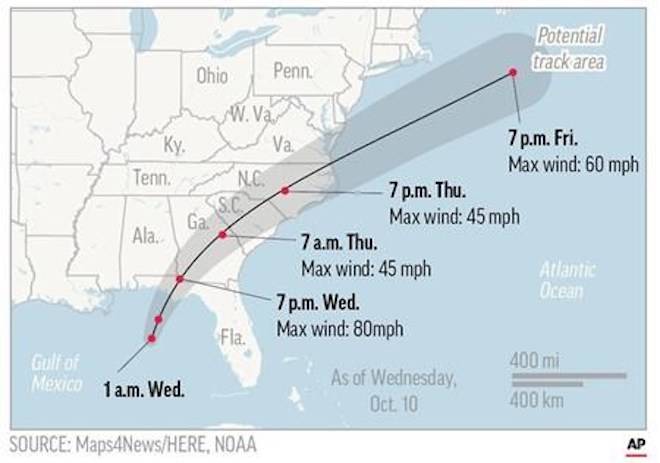Supercharged by abnormally warm waters in the Gulf of Mexico, Hurricane Michael slammed into the Florida Panhandle with terrifying winds of 155 mph Wednesday, splintering homes and submerging neighbourhoods. It was the most powerful hurricane to hit the continental U.S. in nearly 50 years.
Its winds shrieking, Michael crashed ashore in the early afternoon near Mexico Beach, a tourist town about midway along the Panhandle, a lightly populated, 200-mile stretch of white-sand beach resorts, fishing towns and military bases.
It battered the coastline with sideways rain, powerful gusts and crashing waves. It swamped streets and docks, flattened trees, stripped away limbs and leaves, knocked out power to a quarter-million homes and businesses, shredded awnings and sent shingles flying. Explosions apparently caused by blown transformers could be heard.
“We are catching some hell,” said Timothy Thomas, who rode out the storm with his wife in their second-floor apartment in Panama City Beach. He said he could see broken street signs and a 90-foot pine bent at a 45-degree angle.
In Mexico Beach, population 1,000, the storm shattered homes, leaving floating piles of lumber. The lead-grey water was so high that roofs were about all that could be seen of many homes.
Michael was a meteorological brute that sprang quickly from a weekend tropical depression, becoming a fearsome Category 4 by early Wednesday, up from a Category 2 less than a day earlier. It was the most powerful hurricane on record to hit the Panhandle.
“I’ve had to take antacids I’m so sick to my stomach today because of this impending catastrophe,” National Hurricane Center scientist Eric Blake tweeted as the storm — drawing energy from the unusually warm, 84-degree Gulf waters — became more menacing.
More than 375,000 people up and down the Gulf Coast were urged to evacuate as Michael closed in. But the fast-moving storm didn’t give people much time to prepare, and emergency authorities lamented that many ignored the warnings and seemed to think they could ride it out.
“While it might be their constitutional right to be an idiot, it’s not their right to endanger everyone else!” Walton County Sheriff Michael Adkinson tweeted.
Diane Farris, 57, and her son walked to a high school-turned-shelter near their home in Panama City to find about 1,100 people crammed into a space meant for about half as many. Neither she nor her son had any way to communicate because their lone cellphone got wet and quit working.
“I’m worried about my daughter and grandbaby. I don’t know where they are. You know, that’s hard,” she said, choking back tears.
Hurricane-force winds extended up to 45 miles (75 kilometres) from Michael’s centre. Forecasters said rainfall could reach up to a foot (30 centimetres), and the life-threatening storm surge could swell to 14 feet (4 metres).
Related: Supercharged hurricane threatens Florida with 150 mph winds
Related: Hurricane Michael roars towards Florida coast on northern course
A water-level station in Apalachicola, close to where Michael rolled ashore, reported a surge of nearly 8 feet (2.5 metres).
Based on its internal barometric pressure, Michael was the third most powerful hurricane to blow ashore on the U.S. mainland, behind the unnamed Labor Day storm of 1935 and Camille in 1969. Based on wind speed, it was the fourth-strongest, behind the Labor Day storm (184 mph, or 296 kph), Camille and Andrew in 1992.
It appeared to be so powerful that it was expected to remain a hurricane as it moves into Alabama and Georgia early Thursday. Forecasters said it will unleash damaging wind and rain all the way into the Carolinas, still recovering from Hurricane Florence’s epic flooding.
At the White House, President Donald Trump said the government is “absolutely ready for the storm.” ”God bless everyone because it’s going to be a rough one,” he said. “A very dangerous one.”
In Panama City, plywood and metal flew off the front of a Holiday Inn Express. Part of the awning fell and shattered the glass front door of the hotel, and the rest of the awning wound up on vehicles parked below it.
“Oh my God, what are we seeing?” said evacuee Rachel Franklin, her mouth hanging open.
The hotel swimming pool had whitecaps, and people’s ears popped because of the drop in barometric pressure. The roar from the hurricane sounded like an airplane taking off.
Meteorologists watched satellite imagery in complete awe as the storm intensified.
“We are in new territory,” National Hurricane Center Meteorologist Dennis Feltgen wrote on Facebook. “The historical record, going back to 1851, finds no Category 4 hurricane ever hitting the Florida panhandle.”
Colorado State University hurricane expert Phil Klotzbach said in an email: “I really fear for what things are going to look like there tomorrow at this time.”
The storm is likely to fire up the debate over global warming.
Scientists say global warming is responsible for more intense and more frequent extreme weather, such as storms, droughts, floods and fires. But without extensive study, they cannot directly link a single weather event to the changing climate.
With Election Day less than a month away, the crisis was seen as a test of leadership for Scott, a Republican running for the Senate, and Tallahassee Mayor Andrew Gillum, the Democratic nominee for governor. Just as Northern politicians are judged on how they handle snowstorms, their Southern counterparts are watched closely for how they deal with hurricanes.
More than 5,000 evacuees sought shelter in Tallahassee, which is about 25 miles from the coast but is covered by live oak and pine trees that can fall and cause power outages even in smaller storms.
Only a skeleton staff remained at Tyndall Air Force Base, situated on a peninsula just south of Panama City. The home of the 325th Fighter Wing and some 600 military families appeared squarely targeted for the worst of the storm’s fury, and leaders declared HURCON 1 status, ordering out all but essential personnel.
The base’s aircraft, which include F-22 Raptors, were flown hundreds of miles away as a precaution. Forecasters predicted 9 to 14 feet of water at Tyndall.
In St. Marks, John Hargan and his family gathered up their pets and moved to a raised building constructed to withstand a Category 5 after water from the St. Marks River began surrounding their home.
Hargan’s 11-year-old son, Jayden, carried one of the family’s dogs in a laundry basket in one arm and held a skateboard in the other as he waded through calf-high water.
Hargan, a bartender at a riverfront restaurant, feared he would lose his home and his job to the storm.
“We basically just walked away from everything and said goodbye to it,” he said, tears welling up. “I’m freakin’ scared I’m going to lose everything I own, man.”
___
Associated Press writers Tamara Lush in St. Petersburg, Fla.; Terry Spencer in Fort Lauderdale, Fla.; Freida Frisaro in Miami; Brendan Farrington in St. Marks, Fla.; Russ Bynum in Keaton Beach, Fla.; Jonathan Drew in Raleigh, North Carolina; and Seth Borenstein in Kensington, Md., contributed to this story.
Jay Reeves And Brendan Farrington, The Associated Press
Like us on Facebook and follow us on Twitter.

